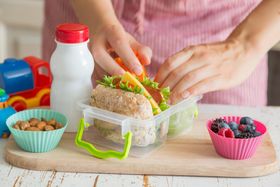How to Teach Your Baby to Chew
Discover useful tips and easy techniques for teaching your baby to chew food.
Updated May 31, 2024

Teaching your baby to chew food can seem like an impossible task, especially if you're doing it for the first time. As a first-time parent, make sure your baby doesn't turn their mouth away when they see you moving in their direction with a spoon.
Next, ensure that the food your baby eats stays in their mouth and doesn't immediately get spit out. It's also essential to ensure your baby chews all the food properly instead of swallowing it immediately.
As you can imagine, this whole process can be quite frustrating for parents. That's why we've put together a comprehensive guide to help you teach your baby to chew quickly and easily.
» Make feeding easier! Explore this infant cereal that supports baby's chewing process
When Is My Baby Ready to Start Chewing?
Most of the time, babies are ready to learn to chew and swallow food around six months. Usually, for the first few months, a baby should be breastfed or bottle-fed exclusively.
Transitioning from a liquid diet to a solid one is not always smooth. Not all babies are ready to learn to chew and swallow at the same age. Some pick it up quickly, whereas it takes others longer to adapt to eating solids.
According to the American Academy of Pediatrics, you should not attempt to teach your baby to chew before they are six months old and showing signs of readiness. Even if babies show interest in food before this age, it doesn't necessarily mean they are ready for solids.
» Learn how to support the baby chewing process with these feeding tips
The good news is that there are some signs you can look out for to ensure your baby is ready to embark on the journey of eating solid foods.
Some of the signs to look for include:
- Baby can sit up independently or with minimal support
- Baby can hold their head up
- Baby has doubled their birth weight
- Baby is no longer using their tongue to push food out
Consulting with your pediatrician before transitioning your baby to solids is recommended. Remember that some babies are more interested in eating than others, so there's no need to rush the process.
What Are the Main Things to Consider When Teaching a Baby to Chew?
It's important to remember that teaching your baby how to chew is not an overnight process. This is because chewing is a progressive skill, meaning the baby needs to develop other skills first to master it. Here are some factors that could affect a baby's ability to chew:
Baby's Age
Babies develop the ability to chew and swallow solid food after six months. This means that they can't develop the ability to chew before being able to swallow solids. Moreover, their digestive system may not be ready for solid food even if the baby is sitting up at four months.
» Learn at what age babies are ready for introducing cereal
Extrusion Reflex
The extrusion reflex is something all babies are born with. It causes them to push any solid objects forward to the front of their mouth with their tongue. This reflex typically takes 4 to 6 months to disappear, but it may also take longer for some babies.
If you notice that your baby still pushes forward with their tongue even if they are six months old, this is a clear sign that they aren't ready to swallow. All you can do is wait a few weeks and then try again.
» Check out expert advice on the extrusion reflex and how to start solid foods
Gag Reflex
This reflex is similar to the extrusion one, but it's designed to protect the baby from choking on solids. The baby will expel food or any other foreign object to the front of their mouth whenever a piece of solid food gets close to the back of their tongue. Like the extrusion reflex, the gag reflex fades away after six months.
» Read this guide on starting finger foods and understanding the gag reflex
Lots of Practice
It may seem like a very simple process to an adult, but chewing is actually a lot of work. The baby needs to learn how to move the food around to break it down and how to use their tongue from side to side before swallowing.
In order for the baby to master the skill of chewing, they need time to practice the initial movements.
» Learn how the right feeding practice can stop your baby from spitting out food
Teething
Even though teething is essential for chewing because that's the only way to break down food into smaller pieces, babies should be acquainted with the basics of chewing by the time they develop teeth.
To do that, babies can chew pureed food and soft food even if they don't yet have teeth. The lower and upper first molar teeth are essential for chewing most types of food, and those emerge by the time your baby is 18 months old. However, by then, the baby should learn the basic tooling movements and perfect them once their teeth erupt.
» Learn how teething might affect your baby’s bottle refusal
5 Tips for Helping Your Baby Learn How to Chew and Swallow Food
Parents can choose from various approaches when it comes to introducing solids. Still, one thing that most pediatricians agree on is that the baby should be offered a variety of textures and tastes.
Texture is one of the most important things to consider when it comes to teaching your baby how to chew. New textures can be confusing for most babies, but fortunately, there are multiple ways to help them transition to solid foods.
» Make feeding nutritious! Explore the top solid foods for your 8-month-old's diet
1. Teething Toys
Most parents think about teething toys only in relation to sore gums, but these toys are actually great for helping babies adjust to the smooth and rough textures they may eventually find in food.
By chewing on toys, babies can also develop their tongue and jaw muscles. This is essential for learning how to move food around as the variety in their diets expands. These toys are specifically designed to increase tactile and sensory stimulation and are great for introducing babies to lumpy food.
Babies can safely put teething toys in their mouths as early as three or four months. Giving it to them regularly before introducing solid foods is always a good idea so the baby can practice and build strength in preparation for the real thing. Moreover, it is important to continue offering babies teethers alongside real food so they can keep building their strength.
» Learn how teething toys can help with baby-led weaning in this guide
2. Serve Foods with Different Flavors and Textures
Offering your baby foods of different flavors and textures is a great way to spark their interest and make the transition from breast milk to solids easier. Whether it's baby rice cereal, mashed fruits like banana or avocado, or vegetable purees, there are many ways to make the journey from liquids to solids easier.
The next step in the baby's transition to solid foods should consist of mashed food such as a banana or cooked vegetables. This will allow the baby to use their chewing skills and jaw muscles.
Finally, when you notice that your baby is handling mashed food well, it's time to start offering them soft finger foods that are easy to manage. For example, you may try frozen mixed vegetables that you cook until soft.
One of the main benefits of using pre-packaged finger foods is that they dissolve quickly, so you don't have to worry about your baby choking while practicing their chewing skills. They are also an excellent choice for eating out, traveling, or any time the baby could do with a snack.
» Discover top snacks! Learn about the best finger foods for your baby
3. Introduce New Foods One At A Time
It's always a good idea to introduce new food items one at a time so the baby gets used to a specific taste and texture before progressing to the next one.
Many babies love mimicking their parents while eating, so you should allow them to sit next to you during breakfast, lunch, or dinner. By allowing babies to watch the rest of the family eat, you may encourage them to pick food in their hands and chew it on their own. This is especially important for babies who don't seem to have a particular interest in food.
» Explore tips for successfully introducing new foods to your toddler
4. Feed the Baby At Fixed Times
Try to offer the baby food at fixed times and ensure they are hungry when introducing new ones. Babies who are already full are unlikely to be enthusiastic about chewing new types of foods.
Help Babies Improve Their Chewing Skills
Once you notice that your baby has become better at chewing and swallowing, you can help them improve their skills. Here are some tips for doing that effortlessly.
- Try to demonstrate to your baby how to eat with their mouth closed. This is something that babies should try to learn sooner rather than later.
- Teach babies to chew their food longer because this will help with digestion.
- Finally, always provide positive reinforcement when the baby does the right thing with chewing. By doing so, you will encourage them to chew and swallow correctly.
Keep in mind that chewing is a skill that comes gradually, which means that not all babies will be mastering it at the same age. Every baby is unique, so if you notice that they have some problem showing for the first time or they're struggling with certain foods, you should always give them more time.
Practice with different foods to see what works best for your baby's first solid foods, and remember to keep them away from tough pieces of food before they learn how to chew and swallow properly. As with most things baby-related, patience always pays off.
The content and advice provided in this article are for informational purposes only and are not a substitute for medical diagnosis, treatment, or advice for specific medical conditions. Always consult a pediatrician to understand the individual needs of your child.








